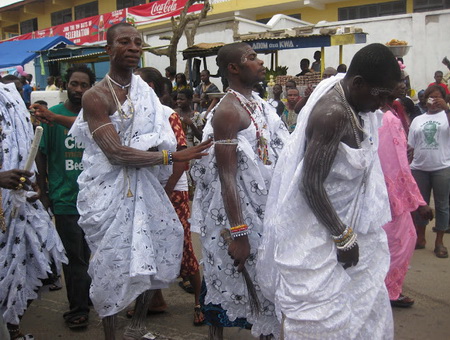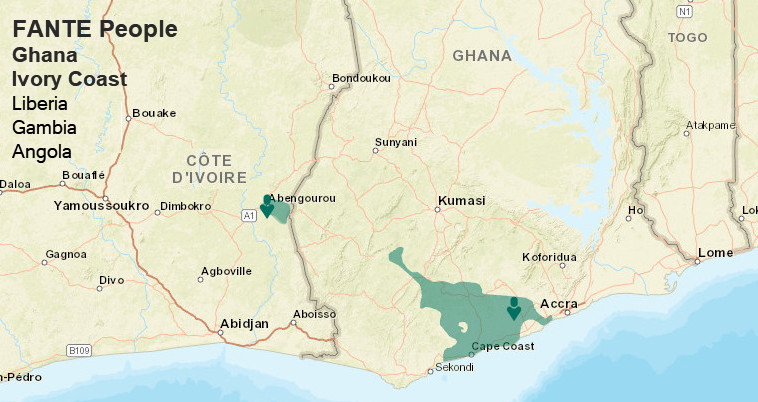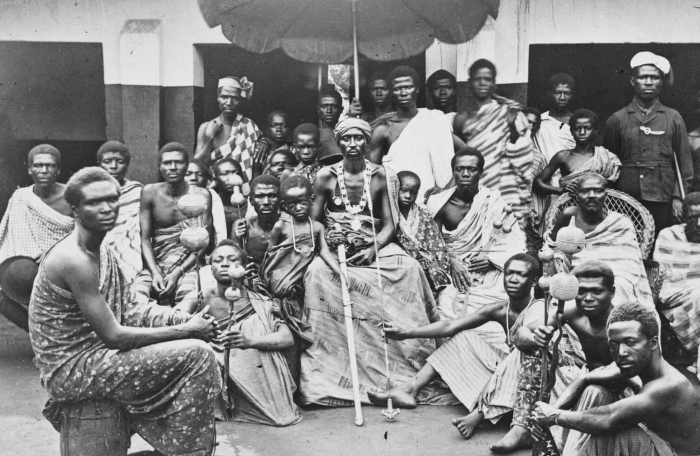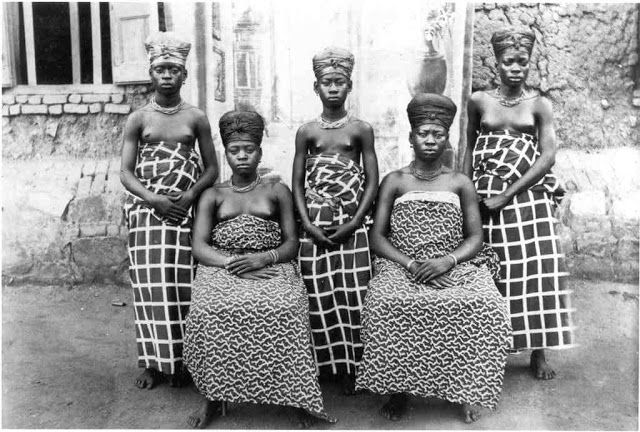

The Mfantsefo or Fante ("Fanti" is an older spelling) are an Akan people.
The Fante people are mainly located in the central coastal regions of Ghana. Over the last half centuries due to fishing expeditions, Fante communities are found as far as Ivory Coast, Gambia, Liberia and even Angola.

Like all Akans, they originated from Bono state. Originally, "Fante" referred to "the half that left" and initially settled at Mankessim. Some of the states that make up the Fante are Agona, Kurantsi, Abura, Anyan, Ekumfi, Nkusukum, Ajumako and Gomoa. The Fante, like other related Akans, trace their roots to the ancient Sahara in the Old Ghana Empire. The Fante then migrated south to modern day Techiman in the Brong Ahafo region. It was from here that, legend say, their three great Leaders, Oson, Odapagyan and Obrumankoma led them south and separated from other Akans, to Mankessim.
The Capital of Fante is Mankessim (Oman kesi mu) , the traditional and spiritual capital of Mfantseman. The Fante people are one of the largest Akan groups, along with the "Asantefo" or Ashantis, the Akuapem, the Akyem, the Bono, The Kwahu, the Baoule, Nzema, Ahanta and others. Despite the rapid growth of the Ashanti Kingdom and constant war with the Ashanti and allied Dutch in the mid 1800s, the Fante have always retained their state to this day and fought numerous wars to protect their northern flank from Ashanti incursion and several other wars.
Currently, they number about 5 million, the second largest grouping of Akan people or about 14% of modern Ghana’s total population. Inheritance and succession to public office among the Fante are traditionally determined by matrilineal descent, which is common among Akan peoples.
According to oral tradition the Fante separated from the other Akan groups in present day Brong Ahafo around 1250 AD. This act became the origin of their name, "Fa-atsew" meaning "half that left". The Fante left their Akan brethren at Krako, present day Techiman in the Bono East of Ghana, and became their own distinct Akan group. The Fante people were led by three great warriors known as Obrumankoma, Odapagyan and Oson (the whale, the eagle and the elephant respectively).
According to tradition, Obrumankoma and Odapagya died on this exodus and were embalmed and carried the rest of the way. Oson led the people to what would become Mankessim in 1252. Legend has it that the Fante's chief priest, Komfo Amona, planted a spear in the ground when they reached the location of the settlement. The spear is called the Akyin-Enyim, meaning "in front of god". The place became the meeting place for the Fante elders and the head fetish priest when discussing important matters.
The first Omanhen (king) of Mankessim was installed here, and later kingmakers would visit the site for consultation. According to the Fante, the spear cannot be removed by mortal hands. The land the Fante reached was initially called Adoakyir by its existing inhabitants, which the Fante called "Etsi-fue-yifo" meaning people with bushy hair. The Fante conquered these people and renamed the settlement Oman-kesemu, meaning large town. The name has evolved into the current name, Mankessim.
The Fante settled the land as their first independent kingdom, and buried Obrumakankoma and Odapagya in a sacred grove called Nana-nom-pow. Komfo Amona also planted the limb of a tree he had brought from the Akan homeland in Krako to see if a place was good for settlement. The day after the priest planted the limb, the people found a tree starting to grow. The tree was named Ebisa- dua, or the consulting tree, and its location is today one of the most important shrines in Mankessim.
The Fante engage in farming, fishing and animal husbandry. Fante society is matrilineal.
A majority of the Fante adhere to Christianity or their traditional beliefs. A significant minority profess Sunni Islam.
When the Portuguese arrived in the 15th century, the Fante prevented them from venturing inland and leased properties for Portuguese trading missions. But when the Portuguese objected to Fante rules and regulations, the Fante expelled them after a series of skirmishes and battles. Thereafter the Dutch arrived, followed by the British. The Fante served as middlemen in the commerce between the interior and British and Dutch traders on the coast. The Fante became a very wealthy and prosperous state upon their dealings with the various European powers.

In the early 18th century, the Modern Fante Confederacy was formed, with the aim of establishing themselves as a nation to be taken seriously by their European counterparts and the withdrawal of Europeans from Fante lands. The Fantes for centuries already had a very complex system of federal government in which various states co-exist in a lose alliance. Each Fante state is led by a Paramount Chief. However in times of war, they always mobilized a Union army often commandeered by the Paramount Chief of Abura. Facing such stern resistance, the Danish vacated all trading forts in Mfantseman. The Dutch, however decided to stay leading to many wars between Fante and the Dutch who failed to colonize them. The British left Cape Coast and moved the capital of Gold Coast to Accra as a response to the resistance movement. The modern Fante Confederacy was established in response to the threat of Europeans attempting to colonize vast areas within modern day Ghana. So in 1844 a bond was signed between the Fante Confederacy, on behalf of the Gold Coast, and the British, allowing the Gold Coast to gain total independence without war one hundred years later.

Several Ashanti-Fante Wars followed due Ashanti quest for direct trade routes to the coast. On one occasion, the Fante were aided by the British, who, however, managed to seriously weaken the strong Fante confederation established between 1868 and 1872, believing it a threat to their hegemony on the coast. The British and the Dutch took sides in these Ashanti-Fante wars thereby creating a schism between these two powerful Akan states. Such European Colonial strategies, later identified as "divide and conquer", are what eventually enabled the entire Gold Coast and many other African nations to be colonized.
Whiles Mfantsefo are known widely to be a peaceful people, in times of war they rally for the common defense. Due to wars with the Dutch and allied Ashanti, the combined strength of the Fante Union Army numbered over thirty thousand men in 1844. It was under the command of Amfo Otu, Paramount Chief of Abura, that they laid siege to their own town of Elmina and its European Castle, eventually expelling the Dutch from their stronghold in Elmina.
One of the social contexts of names among the Akan, including the Fante, is that they are used as social tags to indicate personal and group identity. This is so with family names derived from 12 Ntoro patrilineal clans of the fathers that are given to children. Each of the 12 Ntoro patrilineal clans has its peculiar family names. It is thus possible to use one’s name to trace his/her patrilineal clan. Children who trace their genealogy to one patrilineal father may therefore share similar family names. Typical family names include Yankah, Osam, Aidoo, etc. There have also been innovations as a result of westernization, education and foreign religion. Multiple names have also developed out of this phenomenon. Also, some Fante names are translated literally into English and such anglicised names have come to stay as family names. One can argue that the Fantes living on the coast were the first to be in contact with the Europeans and traded, intermarried and lived with them for over 400 years. It is therefore innervitable the degree of western influences compared to the tribes in the hinterland. Examples of such anglicised transformational name are:
Accordingly, some family names can also be identified by the suffix, for example:
Otherwise, Fante (Akan) typological family names indicate various contexts. They may be circumstantial, manner of birth, theophorous, weird names, insinuating and proverbial names, gang and nicknames, status, occupational, professional, religious, matrimonial, and western names. There can be a combination of two or more of these typological names.
Sources: